Corn Snake Care Sheet
Common Name: Corn Snake Scientific Name: Elaphe guttata guttata Herpetologists may also refer to the Corn Snake under the Latin name of Pantherophis Guttatus Guttatus, as there has recently been a discussion about the re-classification of the Corn Snake's Scientific name. DescriptionDescription: Corns snakes are a relatively small snake from the Colubridae family. They come in a range of different morphs in a variety of colours, but normal (Carolina) corns are bright red to orange with black markings. If you would like to know more about the different morphs available, please see the Morph section on the Forum. Size: 120cm -190cm (4ft-6ft) Life span: (Captive) Pet Corns have the potential to live for over 18 years; records exist of Corns over 22 years of age. Origin: USA (Range found throughout Central and Eastern America) Habitat: Pine forests, rocky outcrops, grasslands, hills and around farms and grain stores. They are often found within corn stores, feeding on the rodents that feed in the corn, hence the name Corn Snake. They are a terrestial species, spening the majority of their time on the ground, but they also appreciate the opportunity to climb. Things to consider before purchasing your first Corn Snake:
You should also consider the availability of Corn Snakes in your area and find out as much about local reptile stockists and breeders before deciding where to purchase your Corn Snake from. It is advisable to buy your snake from a reputable stockist and ensure that they have enough information about the snake's history before you decide to buy. Never buy a snake without adequate feeding and shedding records, as these can tell you a lot about your Corn Snake's state of health. Problem feeders and bad shedders can cause a lot of worry, so ensure that your Corn Snake eats regularly and sheds well before you decide to buy. Choosing your Corn SnakeAlways insist on handling your snake before you decide to buy. This will allow you to notice any health or temperament issues before you take your Corn Snake Home. A healthy Corn Snake will be alert, bright eyed and flicking it's tongue regularly during handling. The skin should be smooth and firm and there should be no traces of retained shed anywhere along the snake's body. If you are in any doubt about the Corn snake's health and well-being then do not purchase it. Corn Snakes can be transported home over short distances in either a RUB (Really useful box/plastic tub with lid) or a cotton bag tied at the top. Most reptile stockists would provide these, but private sellers may not. Quarantining your new Corn Snake is good practice if you have other snakes in the household. 2-3 months should be a minimum quarantine period. Captive CareTemperament: With the odd exception, Corn Snakes are calm, docile, placid snakes that are hardy and thrive very well in captivity. Due to their temperament Corn Snakes are a recommended first snake to keep as they are relatively easy to care for and they also do not outgrow their welcome in the way that some Boas and Pythons can. Corn snakes do make a good choice for beginners since they are easy to handle and care for. However, they are also favorites with experienced keepers due to the vast array of beautiful colors and patterns selective breeding has produced. Corn Snakes make great pets as they are highly unlikely to bite and have pleasant personalities. If threatened their first response is to hide, rather than strike and they will occasionally warn of predators with a little tail rattling. If your Corn Snake rattles it's tail this is nothing to worry about, just take steps to ensure that your Corn Snake feels secure and continue with regular handling until they become used to you and know that you are not a threat to them.
It is important for hygiene reasons to wash your hands with a good anti-bacterial handwash before and after you handle your snake. This is especially important if you have multiple specimens, so has not to pass on any infections between your snakes. Anti-bacterial hand sanitisers are widely available and are useful to have close to your vivarium for quick and regular hand cleaning. Keeping NotesRecord keeping is a good way of monitoring your Corn Snake as it grows and develops. It is advisable to keep a written record of when your snake feeds and sheds it's skin, so that you have a resource to refer to if there becomes a problem. Regular weight and length checks are also useful as you can monitor the growth of your corn, which helps to ensure that your corn is healthy. Feeding
Corn Snakes feed on mice appropriate to the size of their mouth. A prey item should be approximately the same width as one and a half times the size of the corn snakes head. Hatchling Corn Snakes start on pink mice, one every 5-6 days and graduate up to an adult mouse every 7-14 days as they grow. Very large snakes may require 2 adult mice per feed. You may also feed your Corn Snake on chicks and fertilized quail eggs to provide a variation in diet, although these are not recommended as a staple diet as these will not contain all the beneficial nutrients and minerals that rodents have. Larger Corn Snakes will also take other small rodents such as gerbils, hamsters and young rats. Do not feed your snake with live food, even a small mouse may bite or injure your snake. Shop brought frozen rodents are available from most pet shops or bought over the internet these can be thawed to room temperature and make an excellent all round food for your snake. Wild rodents carry parasites and should be avoided at all times. Never handle your snake straight after a feed, as it will regurgitate its meal. It is advisable to wait 48 hours after a feed before handling your snake. Feeding your Corn Snake outside the Vivarium is recommended to ensure that no substrate is ingested along with the prey item. If a Corn Snake ingests large amounts of it's substrate then it can lead to your snake becoming impacted and ill. If your snake is reluctant to feed, which is unlikely in a Corn Snake, then there are a few techniques you can try to encourage your snake to feed. One of these is 'braining' the mouse. Snakes are attracted to the scent of brain matter, so if you cut into the skull of the mouse to expose the brain tissue, then they are more likely to take the food item. Frozen Mice are now available to purchase on Amazon, please use the links below:
Watch the video below to see a corn snake feed:
SheddingCorn snakes, like all other snakes, shed their outer layer of skin periodically throughout their lives. Young snakes may shed more frequently than adult snakes, but in general the shedding process occurs several times a year. This is nothing to worry about as a keeper, but there are a few things you can do to help your snake through this process. Preecdysis is the name given to the changes your snake will go through whilst preparing to shed it's skin. This will include a dulling of your snake's skin colour, general inactivity and their eyes will turn a bluish grey colour. At this time your Corn Snake may refuse a feed or shy away from being handled, but this depends on the individual snake and how they handle preecdysis. While your snake is 'in blue' it is advisable to handle with care as their vision is obscured by the membrane covering it's eyes and they may feel more insecure than usual, therefore more likely to be defensive. Most Corn snakes will handle a shed without any need for extra help, but if you want to assist your snake during this time you should try to raise the humidity in your Vivarium to help your snake loosen it's skin. You can do this by placing a larger water bowl in the vivarium so that your snake has the opportunity to soak itself if desired. You can also lightly mist the tank with water to help raise the humidity. Another useful tactic is to place a humidity box in the Vivarium. This can be a sandwich box with a hole cut in the top filled with damp sphagnum moss. Your Corn snake should appreciate the extra humidity and it will make the next stage in the process easier for it. Ecdysis is the act of shedding, which is usually started by your snake rubbing it's head on rocks or decor to loosen the skin around it's head. Once it has worked it's head free it will continue to crawl its way out of the old skin by rolling it inside out has it moves. Once your snake has shed it's skin it should be removed from the vivarium along with any faeces that usually accompanies Ecdysis. Check your snake to ensure that the shed skin has successfully been removed, taking particular notice that the eyecaps and tail end have not been retained. If necessary bathe your snake and remove any patches of skin that have not been shed with a warm towel or tweezers, to avoid infection or death of the tissue below it. Housing
Corn Snakes are excellent escape artists, so care must be taken when planning their housing. Make sure your vivarium or tank has a tight fitting lid, which can be clamped down. Corn snakes are very strong and can push a loose fitting lid from a vivarium. Corn Snakes are relatively easy to care for, as they defecate rarely, so with regular spot cleaning a full vivarium clean out should only be necessary every 3-5 weeks. When you clean out the housing, disinfect the cage furniture and the inside of the vivarium with a weak disinfectant solution or a reptile safe product. In general, if a disinfectant is safe to use for disinfecting baby bottles, then it is weak enough to use with snakes. Completely dry the contents before replacing in the vivarium with fresh substrate. For hygiene reasons it is advised to use seperate towels and cleaning cloths for your snakes.
Your Corn Snake vivarium should contain:SubstrateWith corn snakes, there are a couple of different substrates that can be used:
At least once a month, all shavings should be removed and disposed of, and the entire enclosure cleaned and disinfected before new shavings are placed inside. Do not use Cedar or Redwood Shavings these are toxic for all animals and should never be used in predator or prey enclosures. Cedar and redwood should not be used in constructing housing for any animal, nor in any furniture or paneling in a vivarium in which any animals are housed. Newspaper: Layers of newspaper have been used for years in animal keeping. It is relatively absorbent when several layers are used, and inexpensive to replace. However, the inks used in printing are known to be harmful to animals. Unprinted sheets may be obtained at shops selling moving supplies, or roll ends may be obtained from some newspaper companies. As with printed newspaper, it is relatively absorbent when several sheets are used, especially when layered with paper towels. Unlike printed newspaper, the unprinted sheets and rolls are not impregnated with potentially harmful inks that could harm your Corn Snake. Easily obtained and relatively inexpensive, paper towels make an excellent substrate for reptiles with belly injuries and those in the early stages of quarantine. Coco/Orchid Bark: Some reptile shops may recommend the use of Coco or Orchid bark for Corn Snakes, but this substrate is more appropriate for snakes that require higher humidity levels. It is unadvisable to use this substrate for Corn Snakes as they are susceptible to respiratory infections (R.Is) if the humidity becomes too high. Astroturf® / Artificial Grass: Astroturf® was the first artificial grass floor covering. Since then, carpet manufacturers have come out with many grades of artificial grass. Hardware shops usually have two or more grades. The least expensive is generally the best to use. It is more flexible, a key factor for thorough cleaning and disinfecting. Pieces can be washed and disinfected repeatedly before they require replacing. Astroturf® is cheap enough that several pieces can be cut for each enclosure and rotated each cleaning day. The pieces of artificial grass substrate sold in small, prepackaged pieces in many pet shops and mail order pet suppliers are the same as the product sold in builder supply shops.
WaterAll Corn Snakes need fresh water to drink daily. Water should be given in a reasonable sized bowl which is fairly heavy to stop your snake tipping it over. Water can also help your snake during shedding at this time your snake may be found bathing in the water. If the snake defecates in its water bowl, the bowl must be cleaned and disinfected immediately. Heat
Heat should be provided using either a heat mat with thermostat or a bulb with a dimming stat on the roof of the vivarium surrounded by a bulb guard. Heat mats should only cover between a third and a half of the floor space to allow your snake to thermo-regulate. This heat mat should be regulated by a thermostat to ensure that it does not overheat. Since a heat mat should provide sufficient heat to keep your corn snake happy, a basic mat stat, like the Microclimate Ministat 100 or the Habistat Mat Stat, should be appropriate. These thermostats are available from reptile shops and online, are relatively cheap, and will ensure the heat source is regulated at a safe level. A popular alternative to the heat mat is a normal light bulb on the roof of the vivarium, attached to a dimming stat. It is important to ensure that the heat source is protected from direct contact with you snake by using a guard. Corn snakes do not feel heat in the same way that we do and do not always realise that something they are touching is burning them. A bulb guard will ensure that your Corn snake will stay a safe distance away from the heat of the bulb so burns will be avoided. The disadvantages of using a bulb as a heat source is that the bulb needs to be turned on constantly to keep the vivarium at the correct temperature. Your corn snake does not require light 24 hours a day and can suffer from stress if the light exposure is too long. It is recommended to keep your corn snake in a natural light pattern that mimics normal daytime, so a heat mat is a better choice between the two heat sources. If you do decide to use a heat mat, then a energy-saving bulb with guard can be added to the vivarium for decorative purposes to help you see your snake. It's useful when using either method to have a small thermometer on each end of the vivarium to check the temperature. Place the thermometers near the hides on top of the substrate as this is where your Corn snake will spend the majority of it's time. One end should be around 30°C and the other around 21°C. Checking temperatures regularly is advised to ensure that your Corn Snake can thermo-regulate by moving around the tank
A place for your Corn Snake to hide
Specialist reptile hides can be purchased from pet shops and over the Internet. These are usually quite expensive, but look good inside the vivarium and can be easily cleaned when you clean the rest of the vivarium.. Any hide should be just large enough for your Corn Snake to curl up in; if it is too large the snake will not feel as secure. It is advised to place at least two hides in your vivarium so that your Corn snake will have a place to hide in both the warm and cool end of the tank. In general, it is wise to place two hides in your vivarium for your Corn snake to use, one in the warm side of the vivarium and one in the cooler side. This enables your snake to have adequate hiding places along the temperature gradient, which would allow your snake to adjust its body temperature. This is important, because for some Corn Snakes, the instinct to hide is often more insistent than the instinct to keep at the right temperature. If the snake does not control his body temperature it can lead to many problems, the least of which being digestive problems. A place to climb
Branches and rocks collected from the wild will need to be debugged by soaking first in chlorine/water solution, then rinsed thoroughly, soaked in clean water, then left to dry in the sun. Aternatively, baking your find in a oven for an hour at 100°C would also kill any parasites or bacteria living on it that could harm your snake. Some live plants may be harmful to your Corn Snake, if in doubt don't use them in your Vivarium. A change of sceneryCorn snakes are very inquisitive animals and like to explore new surroundings. Once in a while change the layout of the vivarium, as this will keep your Corn Snake from becoming bored. You will notice once you put your Corn Snake back in the tank it will start to re-explore its new surroundings. HumidityCorn Snakes do not require a specific humidity level, but may appreciate a light misting of their vivarium to aid them during the shedding process. Ensure that you do not allow the humidity to reach too high a level as this may cause your Corn Snake to develop an R.I (Respiratory Infection). Social StructureIn the wild, Corn Snakes are individualists and in the main lead a solitary life. There is an ongoing debate as to whether captive Corn Snakes should be housed together. Some keepers can keep multiple specimens within one Vivarium with no problems, but others have found out the hard way not to keep Corn Snakes together as they become stressed. In general, some people would say that captive females can be kept together with no problems, but males have been known to harass each other particularly in the breeding season, so should be kept singly. It is recommended that adult animals of opposite sex should be kept apart unless you want to breed from them. If you do house your Corn Snakes together, make sure you check on them regularly so any problems can be sorted out immediately. They should also be fed separately outside the vivarium, to ensure they do not compete for food. SexingThere are many techniques you can use to sex your snake, including comparing tail lengths visually as males tend to have longer tails than females, but the only two accurate ways of determining corn snake sex are Popping and Probing. Popping is usually done on hatchling corns and Probing on older specimens. Both techniques should only be carried out by an experienced snake keeper or herptologist, as your Corn Snake can be hurt if the procedure is not done properly. Breeding
Corn Snakes breed so well in captivity that it is unusual to find any wild caught animals for sale. They come in an ever-growing range of colour and pattern mutations, which can lead to a very varied collection of just one species. Corn snakes should be of a good age and weight before they are allowed to breed to avoid problems like egg binding. I would recommend that the minimum requirements for a female to breed would be at least 3 years of age, 3ft in length and 300 grams in weight. Brumation Mating Laying Incubation Hatchlings Once they are out of the egg, the hatchlings will all need to be housed separately. Small sandwich box type RUBS (Really Useful Boxes) are good for housing your hatchlings at this stage. Hatchlings will require their first feed after their first shed, which should occur around a week after they hatch. If the hatchling is reluctant to eat it's first pinky, try braining the pinky to encourage them to take it. If you are planning to sell on your hatchlings, it is important to ensure that the hatchlings are readily accepting food and are healthy before selling them. Common ComplaintsCorn Snakes are a hardy snake that would rarely become ill with appropriate care, but here is a quick introduction to a few disorders that need to be looked out for.
Respiratory Infections (R.Is): R.Is are a bacterial infection that is usually caused by poor cage conditions, low temperatures or too much humidity, but can be passed from snake to snake too. Corn Snakes may sound wheezy with excessive saliva and nasal discharge. Their mouths may also gape open as your corn struggles to breathe. Very mild R.Is may go away themselves if the conditions that the snake are living in are corrected, but serious infections need to be seen to by a vet immediately to avoid Mouth Rot or even death of your Corn Snake. The vet may prescribe an anti-biotic called Baytril, which is safe enough to be given to your snake. Regurgitation: When a snake regurgitates it's meal, it may not necessarily be down to illness, but as regurgitation is a symptom of many digestive problems, illnesses and stress it is recommended that if your Corn Snake does regurgitate it's meal that you monitor your snake very closely for further symptoms. Sometimes a Corn Snake may regurgitate it's meal if it is handled too soon after a feeding or if it has been fed an item that is too large for it. In this case, you should leave the snake to settle back down for a week before trying to feed again. If your Corn Snake repeatedly regurgitates it's meal, loses excessive weight or shows any other signs that are worrying you, seek medical attention as soon as possible. Further Information
|
|

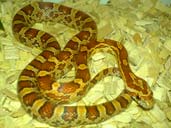
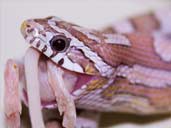
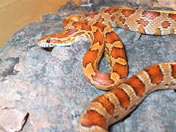
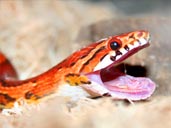
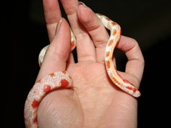
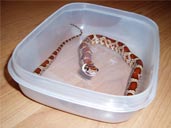
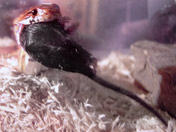
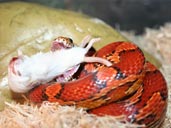
head_coming_loose_small.jpg)
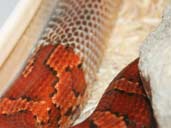
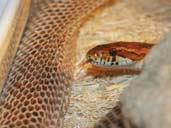
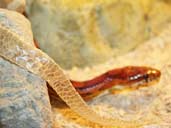
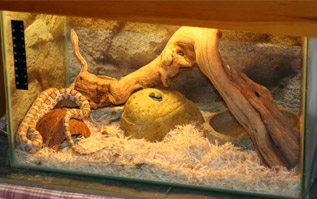 Corn Snakes are not highly active and do not need huge enclosures. A medium sized vivarium (Even a fish tank with a tight fitting lid) will house your Corn Snake nicely. The vivarium should allow a minimum of 1 square foot of floor space to each foot of snake and be approximately a third of the snake’s length in height. Hatchlings should start out in an appropriately sized small vivarium as they can become stressed and stop feeding in an oversized vivarium.
Corn Snakes are not highly active and do not need huge enclosures. A medium sized vivarium (Even a fish tank with a tight fitting lid) will house your Corn Snake nicely. The vivarium should allow a minimum of 1 square foot of floor space to each foot of snake and be approximately a third of the snake’s length in height. Hatchlings should start out in an appropriately sized small vivarium as they can become stressed and stop feeding in an oversized vivarium. 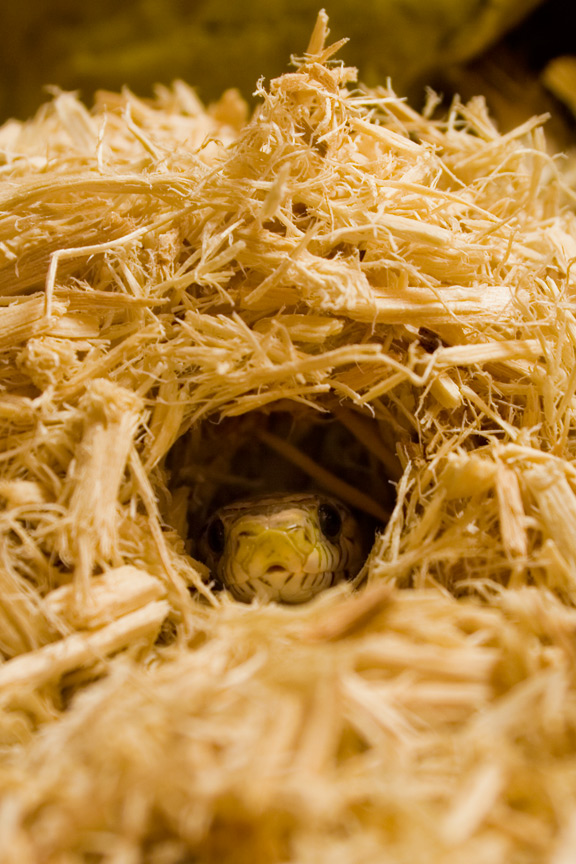 Aspen Shavings: Aspen shavings may be used for Corn Snakes. The shavings cannot be cleaned and so have to be removed and replaced with fresh shavings when dirty. If you use aspen shavings the urine and feaces can be scooped out with a cat litter scoop, and replaced with fresh shavings as needed. Be sure to remove soiled substrate as soon as possible; urine-soaked material will become a breeding ground for bacteria, which could harm your Corn Snake. If you use this type of substrate you will have to place your snake in a secure area to feed it; you do not want it to ingest any of the shavings.
Aspen Shavings: Aspen shavings may be used for Corn Snakes. The shavings cannot be cleaned and so have to be removed and replaced with fresh shavings when dirty. If you use aspen shavings the urine and feaces can be scooped out with a cat litter scoop, and replaced with fresh shavings as needed. Be sure to remove soiled substrate as soon as possible; urine-soaked material will become a breeding ground for bacteria, which could harm your Corn Snake. If you use this type of substrate you will have to place your snake in a secure area to feed it; you do not want it to ingest any of the shavings.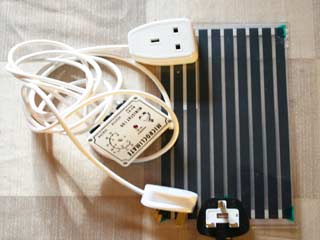 Corn Snakes are cold blooded and get heat from their surroundings. In the wild snakes bask in the sun to keep warm or move to a shady spot if they are too hot, this is called thermo-regulation. The ideal temperature for you snake's vivarium is a temperature gradient of 21-30°C (70-86°F)
Corn Snakes are cold blooded and get heat from their surroundings. In the wild snakes bask in the sun to keep warm or move to a shady spot if they are too hot, this is called thermo-regulation. The ideal temperature for you snake's vivarium is a temperature gradient of 21-30°C (70-86°F)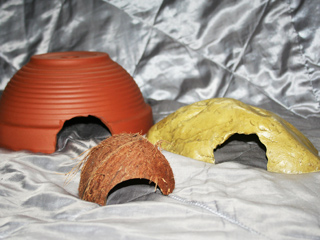 All Corn Snakes need somewhere to hide and may become stressed if this is not provided. This could be a cardboard box, a toilet roll tube or a upturned plant pot that can be easily replaced if it becomes soiled.
All Corn Snakes need somewhere to hide and may become stressed if this is not provided. This could be a cardboard box, a toilet roll tube or a upturned plant pot that can be easily replaced if it becomes soiled. 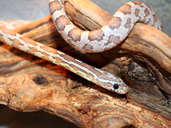
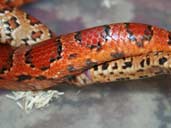
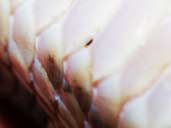 Mites: Mites are little black parasites that live on your Corn Snake and feed on their blood. If your Corn Snake catches mites they can usually be found around the eyes, mouth and under scales. Your snake will seem lethargic and may go off it's food during a mite infestation. If you discover mites on your corn snake, immediately bathe your snake in warm water and fully disinfect the entire tank and contents. Refill your vivarium with white kitchen roll and leave the cage furniture to a minimum. This helps stops the mites being able to breed as they need substrate to lay eggs and also allows you to see them more clearly while you monitor your snake. Repeated bathing and disinfecting of the vivarium helps, but it unlikely that you will remove a mite infestation without some sort of treatment. Reptile shops sell various treatments to help kill off the mites, but some vets may prescribe a weak dose of Frontline if they feel it is necessary.
Mites: Mites are little black parasites that live on your Corn Snake and feed on their blood. If your Corn Snake catches mites they can usually be found around the eyes, mouth and under scales. Your snake will seem lethargic and may go off it's food during a mite infestation. If you discover mites on your corn snake, immediately bathe your snake in warm water and fully disinfect the entire tank and contents. Refill your vivarium with white kitchen roll and leave the cage furniture to a minimum. This helps stops the mites being able to breed as they need substrate to lay eggs and also allows you to see them more clearly while you monitor your snake. Repeated bathing and disinfecting of the vivarium helps, but it unlikely that you will remove a mite infestation without some sort of treatment. Reptile shops sell various treatments to help kill off the mites, but some vets may prescribe a weak dose of Frontline if they feel it is necessary. 